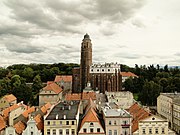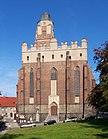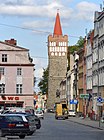Paczków
Paczków | |
|---|---|
 Paczków Town Hall | |
|
UTC+2 (CEST) | |
| Postal code | 48-370 |
| Vehicle registration | ONY |
| Website | http://www.paczkow.pl |
Historic Monument of Poland | |
| Designated | 2012-10-22 |
| Reference no. | Dz. U. z 2012 r. poz. 1240[2] |
Paczków
The old town and its medieval fortifications are listed as one of Poland's official national
History

Paczków was officially founded and granted
In the Late Middle Ages and subsequent periods, Paczków shared the stormy fate of other towns of Silesia, with frequent disasters, such as hunger (1325), floods (1333, 1501, 1539, 1560, 1598, 1602), fires (1565, 1634), as well as epidemics - Black Death (1349), and cholera (1603–1607, 1633). The town also suffered during the Hussite Wars, when it was captured by the Hussites on March 17, 1428.[9] The period of religious wars did not end until the late 15th century, and only then did Paczków begin to flourish again. With the financial support of the dukes of Nysa, new fortifications were constructed, with a wall and towers.
In 1526 Paczków, under the Germanized name Patschkau, together with the Duchy of Nysa, passed under the suzerainty of the
The town was spared from serious destruction during
Monuments

Unlike nearby Nysa, World War II spared Paczków, and most of its monuments have been preserved. Called "The Polish Carcassonne" (or, before the town was reintegrated with Poland, "the Silesian Carcassonne"), as early as in the 15th century, it was surrounded by double ring of defensive walls. Initially, the fortifications were made of dirt and wood, but later they were replaced by mightier stone walls.
The first fortifications of Paczków were built in the mid-14th century upon the order of the Bishop of
Besides its fortifications, Paczków is famous for
Another interesting monument of "Polish Carcassonne" is the
Economy

The characteristics of the town of Paczków's economic dependence is similar to that of the
To the west of Paczków, the
Notable people
- Joseph Schröter (1837–1894), German scientist
- Lucyna Matuszna (born 1961), Polish female field hockey player
- Izabela Zatorska (born 1962), Polish retired female mountain runner
- Paweł Kukiz (born 1963), Polish politician, singer and actor
- Krzysztof Maksel (born 1991), Polish male cyclist
Twin towns – sister cities
See twin towns of Gmina Paczków.
Gallery
-
Town centre
-
Kłodzko Gate
-
Historic townhouses
-
Wrocław Gate
-
Market square
-
Church of Our Lady of Perpetual Help
-
Executioner's house, 18th century
References
- ^ "Population. Size and structure and vital statistics in Poland by territorial division in 2019. As of 30th June". stat.gov.pl. Statistics Poland. 2019-10-15. Retrieved 2020-02-14.
- ^ Rozporządzenie Prezydenta Rzeczypospolitej Polskiej z dnia 22 października 2012 r. w sprawie uznania za pomnik historii "Paczków - zespół staromiejski ze średniowiecznym systemem fortyfikacji", Dz. U. z 2012 r. poz. 1240
- ^ a b c d Gazeta Wyborcza. Piotr Walczak, Odwiedz polskie Carcassonne (Visit Polish Carcassonne) Archived 2008-09-15 at the Wayback Machine retrieved on April 21, 2009
- ^ a b c Panorama of Polish cities. Silesian Carcassonne Archived 2007-10-16 at the Wayback Machine
- ^ Poland’s Official Travel Website, Paczkow - Polish Carcassonne
- ^ Castles.info, Silesia and Opolskie
- ^ a b c d e "Historia miasta". Paczków - oficjalna strona internetowa (in Polish). Retrieved 22 March 2020.
- ^ Hans-Georg Mohr, Leo Schiller (Hrsg.): 1254–2004. 750 Jahre Patschkau. Die Geschichte der Stadt Patschkau in Schlesien. Dohlenverlag, Osnabrück 2004, S. 19: German text of the founding document
- ^ a b c History of Paczkow at portal paczkow info Archived 2009-02-27 at the Wayback Machine
- ^ "Working Parties". Stalag VIIIB 344 Lamsdorf. Retrieved 22 March 2020.
- ^ Official webpage of town and commune of Paczkow Archived 2009-04-17 at the Wayback Machine
- ^ Carta Blanca Publishing House, Paczkow
- ^ "Infrastruktura". paczkow.pl (in Polish). Retrieved 31 January 2017.
- ^ "Start - Pollena Paczków". Pollena Paczków (in Polish). 23 June 2014. Retrieved 31 January 2017.
- ^ "Paczków". www.polskawliczbach.pl (in Polish). Retrieved 31 January 2017.
External links
- Official webpage of the town
- Photo gallery of Paczkow
- Jewish Community in Paczków on Virtual Shtetl









